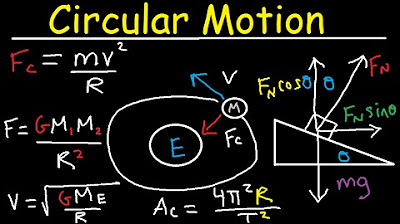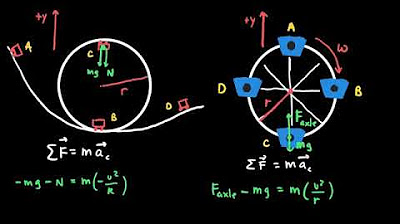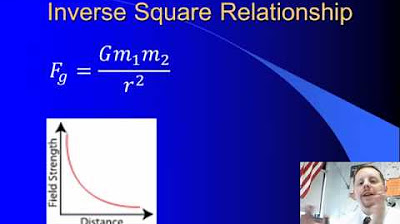High School Physics - Orbits
TLDRIn this educational talk, Mr. Fullerton explains the concept of orbits and the phenomenon of apparent weightlessness experienced by objects in orbit. He uses the analogy of a cannonball fired from a mountain to illustrate how an object can continuously fall towards Earth while moving forward fast enough to maintain a stable orbit. The discussion includes calculations of gravitational force and centripetal acceleration, highlighting the differences in gravitational pull experienced by satellites at various distances from Earth. The talk is informative and engaging, providing a deeper understanding of the physics behind orbital mechanics.
Takeaways
- 🌌 Orbits are derived from Newton's thought experiment of a cannonball fired from a mountain high enough to avoid air resistance.
- 🚀 Apparent weightlessness in orbit is due to the constant acceleration of the object as it falls around the Earth, maintaining a stable altitude due to its tangential velocity.
- 📐 The gravitational field strength at the altitude where the Space Shuttle orbits (380 km above Earth's surface) is about 8.75 Newtons per kilogram, 11% less than on Earth's surface.
- 🌍 The Earth's orbit around the Sun is maintained by a centripetal force, which is the gravitational pull from the Sun.
- ⚖️ The magnitude of the centripetal force acting on Earth due to its orbit around the Sun can be calculated using the mass of Earth, the square of its orbital velocity, and the radius of its orbit.
- 🛰️ The Space Shuttle travels at approximately 7680 meters per second to maintain its orbit, which is over 17,000 miles per hour or 23 times the speed of sound at sea level.
- 🔁 The concept of orbits is based on the balance between the gravitational force pulling an object towards the Earth and the object's inertia from its velocity keeping it in a curved path.
- 📐 For satellites in orbit, the gravitational force of attraction between the satellite and the planet is inversely proportional to the square of the distance between them.
- 🌠 Satellites at different orbital radii experience different gravitational forces, with those closer to the planet experiencing a stronger force.
- 🔗 Newton's law of universal gravitation is fundamental in understanding and calculating the gravitational forces and the resulting motions in celestial mechanics.
- 📈 The principles of orbits and gravitational forces can be explored further through educational resources such as those found on physics websites and platforms.
Q & A
What is the concept of apparent weightlessness in orbit?
-Apparent weightlessness in orbit refers to the condition where objects, despite being under the influence of gravity, appear to be weightless because they are moving at a speed that allows them to continuously fall around the Earth without ever actually hitting the ground. This creates a sensation of weightlessness as the objects and the inhabitants within them (like astronauts) are in freefall around the Earth.
How does Newton's thought experiment with a cannon relate to orbiting objects?
-Newton's thought experiment demonstrates the principle of orbits by illustrating that if a projectile is launched with sufficient velocity, it will continue to travel around the Earth without ever hitting the ground. This is because the Earth's curvature means the ground 'falls away' underneath the projectile as it moves forward, creating a continuous state of freefall, which is the essence of an orbit.
What is the gravitational field strength experienced by the Space Shuttle in orbit?
-The gravitational field strength experienced by the Space Shuttle in orbit, at an altitude of 380 kilometers above the Earth's surface, is approximately 8.75 Newtons per kilogram, which is about 11% less than the gravitational acceleration experienced on the Earth's surface (9.8 m/s^2).
How fast does the Space Shuttle travel to maintain its orbit?
-To maintain its orbit, the Space Shuttle travels at approximately 7,680 meters per second, which is over 17,000 miles per hour or roughly 23 times the speed of sound at sea level.
What is the centripetal force that keeps the Earth in its orbit around the Sun?
-The centripetal force that keeps the Earth in its orbit around the Sun is calculated by multiplying the mass of the Earth (5.98 x 10^24 kg) by the square of its orbital speed (3 x 10^4 m/s) and dividing by the radius of its orbit from the Sun's center to the Earth's center (1.5 x 10^11 m). The result is approximately 3.5 x 10^22 Newtons.
How does the gravitational force of attraction differ between two satellites at different distances from a planet?
-The gravitational force of attraction between a satellite and the planet is inversely proportional to the square of the distance between them. If one satellite (A) is at a distance of 1 R from the planet's center and another (B) is at a distance of 2 R, the force of attraction on B would be 1/4 that of A, due to the inverse square law relationship.
What is the significance of the Earth's curvature in maintaining its orbit around the Sun?
-The Earth's curvature is significant in maintaining its orbit around the Sun because it allows the Earth to continuously fall around the Sun without ever colliding with it. The Earth's path is an elliptical orbit, not a perfect circle, but the curvature still ensures that the gravitational force acts as a centripetal force, keeping the Earth in its orbital path.
How does the velocity of an object in orbit affect its gravitational field strength?
-The gravitational field strength is not directly affected by the object's velocity. However, the velocity does determine how the object maintains its orbit. An object in orbit must have a sufficient velocity to counteract the gravitational pull and maintain its trajectory. If the velocity is too low, the object will fall back to Earth; if it's too high, it may escape Earth's gravitational pull.
What is the role of the universal gravitational constant (G) in calculating gravitational forces?
-The universal gravitational constant (G) is a fundamental constant that appears in Newton's law of universal gravitation. It is used to calculate the gravitational force between two masses (m1 and m2) by multiplying the product of the masses by G and dividing by the square of the distance (R^2) between their centers. The value of G is approximately 6.674 x 10^-11 N(m/kg)^2.
What is the relationship between the mass of the Earth and the gravitational force it exerts?
-The mass of the Earth directly influences the gravitational force it exerts. According to Newton's law of universal gravitation, the gravitational force between two objects is directly proportional to the product of their masses. The Earth's mass (approximately 5.98 x 10^24 kg) is a key factor in determining the strength of the gravitational force it exerts on objects, including those in orbit.
How does the concept of freefall relate to objects in orbit?
-Objects in orbit are in a state of continuous freefall. They are falling towards the Earth due to gravity, but because they are moving horizontally at a high speed, they keep missing the Earth's surface. This constant falling while moving forward at the right speed creates the sensation and condition of being in orbit, which is essentially a high-speed balance between the object's forward motion and the gravitational pull of the Earth.
Outlines
🌌 Understanding Orbits and Apparent Weightlessness
This paragraph introduces the concept of orbits and apparent weightlessness experienced by objects in space. It starts with a thought experiment by Isaac Newton, imagining a cannon on a mountain high enough to be above the Earth's atmosphere. The discussion explains how increasing the velocity of a cannonball would result in it traveling further before returning to Earth, and with enough velocity, it would continuously fall around the Earth in an orbit. The key point is that objects in orbit are not weightless due to the absence of gravity, but because they are moving so fast that they are constantly falling around the Earth's curvature. The paragraph also explains how to calculate the gravitational field strength experienced by the Space Shuttle in orbit using Newton's law of universal gravitation. It concludes by noting that the Shuttle's orbit requires it to travel at a very high speed to maintain its position in orbit.
🚀 Calculating Centripetal Force and Gravitational Attraction in Orbits
This paragraph delves into the calculation of centripetal force and gravitational attraction in orbits. It begins with a sample problem to calculate the centripetal force acting on the Earth as it orbits the Sun, given a circular orbit and a specific orbital speed. The centripetal force is determined by the mass of the Earth, the square of its orbital speed, and the radius of its orbit around the Sun. The paragraph then compares the gravitational force of attraction between two satellites of equal mass in different orbits around a planet, highlighting the inverse square law relationship. The key takeaway is the significant force required to maintain Earth's orbit around the Sun and the importance of understanding gravitational forces and orbital mechanics for satellites and celestial bodies.
Mindmap
Keywords
💡Orbits
💡Apparent Weightlessness
💡Newton's Law of Universal Gravitation
💡Centrifugal Force
💡Parabolic Path
💡Gravitational Field Strength
💡Centripetal Acceleration
💡Circular Orbit
💡Inertia
💡Projectile Motion
💡Inverse Square Law
Highlights
Explaining the concept of apparent weightlessness in orbit.
Isaac Newton's thought experiment of a cannon on a mountain above the atmosphere.
The idea that an object in orbit is constantly falling but moving fast enough to stay at the same altitude.
Calculating the gravitational field strength for the Space Shuttle in orbit using Newton's law of universal gravitation.
The Space Shuttle experiences an acceleration due to gravity about 11% less than on Earth's surface.
The Space Shuttle travels at approximately 7680 meters per second to maintain its orbit.
Calculating the magnitude of the centripetal force acting on the Earth as it orbits the Sun.
The Earth's orbit around the Sun is not perfectly circular but close enough for this example.
The centripetal force is caused by gravity and is calculated as mass times the square of velocity divided by the radius.
The Earth's mass and its orbital speed are used to calculate the force keeping it in orbit around the Sun.
Comparing the gravitational force of attraction between two satellites and a planet at different distances.
Satellite B, being twice as far from the planet as Satellite A, experiences 1/4 the gravitational force.
The inverse square law relationship in gravitational force calculations.
The importance of understanding orbits for space travel and satellite deployment.
The practical applications of these concepts in space missions and satellite technology.
The educational value of these concepts for students and enthusiasts of physics and astronomy.
The potential for further exploration and discovery in space enabled by understanding orbits.
Transcripts
Browse More Related Video

Newton's Law of Universal Gravitation

Centripetal Acceleration & Force - Circular Motion, Banked Curves, Static Friction, Physics Problems

AP Physics 1 Circular Motion and Gravitation Review

Centripetal force and acceleration intuition | Physics | Khan Academy

Calculating the Gravitational Force

High School Physics - Newton's Law of Universal Gravitation
5.0 / 5 (0 votes)
Thanks for rating: